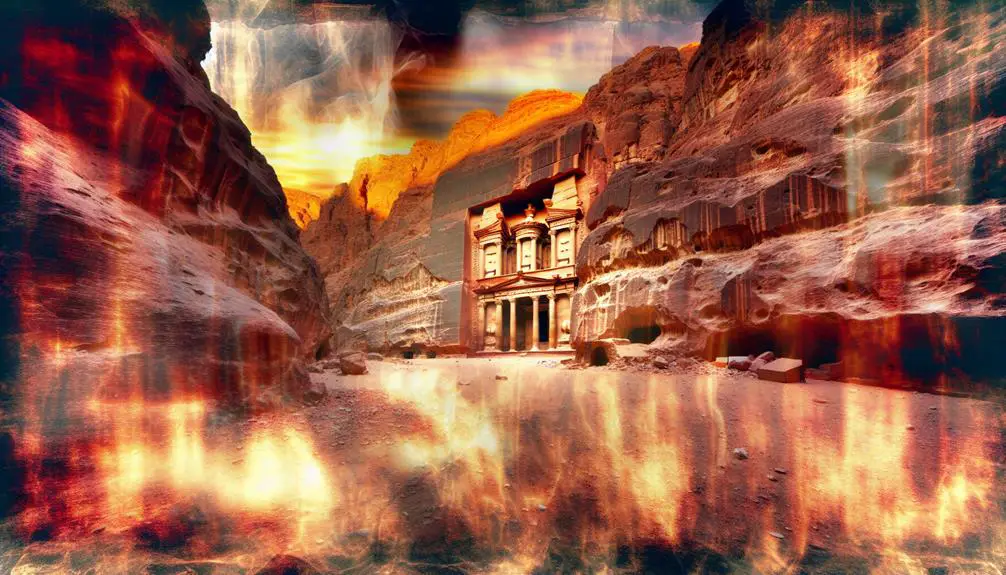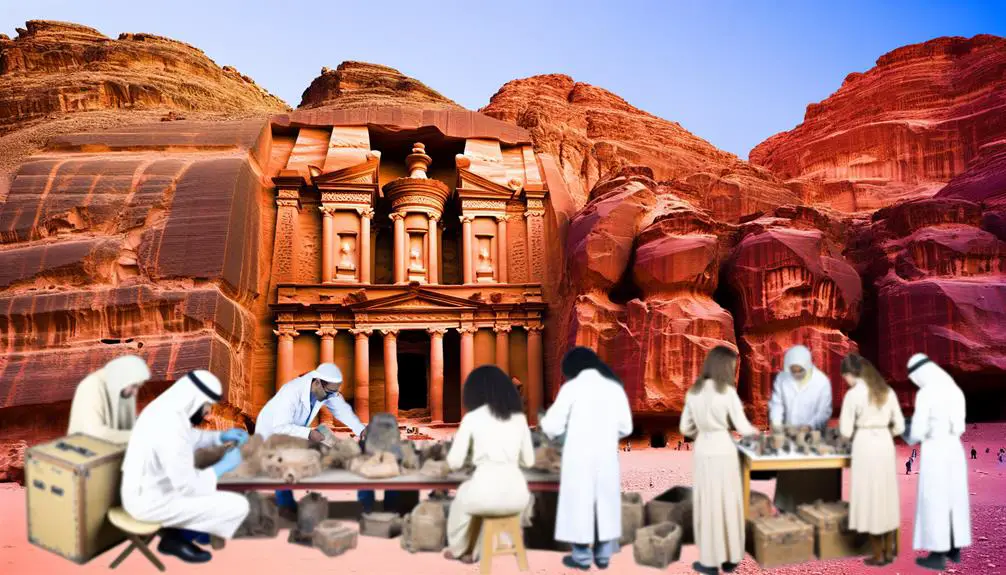Step into the enigmatic world of Petra to unveil its biblical mysteries and decipher its ancient whispers echoing through the sands of time.

Petra in the Bible
Imagine you're walking through the Siq, the narrow gorge leading into the ancient city of Petra, just as early Christians might have on their pilgrimages. This city, carved from rose-red stone, holds secrets that intertwine with biblical narratives, yet its exact role within the scriptures remains a subject of debate among scholars.
You've likely heard of Petra's grandeur and mystery, but have you considered how its history and archaeology might shed light on its biblical significance? As we explore the historical background, prophecies, and archaeological findings, you'll discover intriguing theories about Petra's place in early Christianity and its enduring allure in modern times.
Key Takeaways
- Petra's geological features and strategic location align with indirect mentions in biblical texts.
- Biblical prophecies hint at Petra's significant symbolic role in future events.
- Interpretations of prophecies involving Petra enrich scholarly and religious discussions.
- Petra's historical and spiritual importance is analyzed through biblical descriptions and prophecies.
Historical Background of Petra

Petra, an ancient city carved from the rose-red cliffs in Jordan's southwestern desert, boasts a history that dates back over 2,000 years, serving as a crucial commerce hub and cultural melting pot in the region. Its strategic location along vital trade routes facilitated the exchange of goods, ideas, and cultural practices between the civilizations of the ancient Near East, Africa, and the Mediterranean. The Nabateans, an industrious Arab people, founded Petra and harnessed the city's unique position to amass wealth and influence through trade. They're also credited with the development of Nabatean architecture, a distinctive blend of native traditions and Hellenistic influences, which is epitomized in Petra's iconic façade of Al Khazneh (The Treasury).
The city's architecture and hydraulic engineering systems reflect a sophisticated understanding of both aesthetics and functionality, enabling the Nabateans to thrive in the harsh desert environment. Petra's significance as a trade center waned with the shifting of trade routes and the Roman annexation, yet its architectural and cultural legacy endures, offering invaluable insights into the ancient world's complexity.
Petra in Biblical Texts
You'll find Petra's presence in biblical texts both intriguing and complex, as it's mentioned indirectly through various scriptural references and prophecies.
These passages not only illuminate Petra's historical and spiritual significance but also how it intertwines with broader biblical narratives.
Petra's Scriptural References
Exploring biblical texts reveals that Petra holds significant yet understated references within the scriptural narrative. Though not explicitly named, the site's geological features and architectural styles offer clues to its presence in these ancient writings. You'll notice descriptions that align closely with Petra's unique landscape—towering rock formations and elaborate facades carved directly into the rose-red sandstone.
These elements suggest the city's importance, not just as a historical and archaeological marvel, but also within the biblical context. Scholars analyze these passages, drawing connections between the physical characteristics of Petra and the locations mentioned in the scriptures.
This analytical approach allows for a deeper understanding of Petra's role in the biblical era, highlighting its significance beyond mere historical or cultural interest.
Prophecies Involving Petra
While not explicitly named, several prophecies within biblical texts are believed to involve Petra, offering a deeper insight into its spiritual significance. These prophecies, rich in metaphor and symbolism, hint at events with profound geopolitical implications, underscoring Petra's role in the unfolding of historical and eschatological narratives. Analysts and scholars often interpret these texts as foretelling moments of upheaval and transformation, suggesting that Petra's significance extends beyond its archaeological grandeur to encompass a pivotal role in prophetic fulfillment.
This interpretation hasn't only enriched the scholarly discourse on Petra but has also enhanced its allure for religious tourism. As a site perceived to be at the crossroads of prophecy and history, Petra attracts visitors eager to connect with a place imbued with deep spiritual resonance, thus intertwining its ancient past with contemporary religious and geopolitical narratives.
Prophecies Involving Petra

You'll find that biblical prophecies involving Petra and Edom's role in end times offer a complex layer of interpretation and significance.
These texts suggest Petra's strategic and symbolic importance in prophetic scenarios, highlighting its connection to the fate of nations.
Examining these prophecies reveals insights into ancient beliefs and future expectations surrounding this historic site.
Petra's Prophetic Significance
Why does Petra hold a unique place in biblical prophecy? This ancient city isn't just a marvel of geological significance; it's also a site of profound prophetic importance. Here's why:
- Geological Significance: Petra's unique rock formations and rugged terrain have made it a symbol of natural strength and fortitude in prophetic narratives.
- Tourism Impact: The influx of visitors drawn by its historical and biblical ties has spotlighted Petra's prophetic roles, amplifying its significance in contemporary religious discussions.
- Scriptural References: Biblical texts allude to Petra in prophecies concerning the end times, highlighting its spiritual and protective roles.
- Prophetic Imagery: Its remote location and fortress-like qualities have led scholars to speculate about its place in future events, as foretold in scripture.
Petra's blend of natural beauty, historical depth, and prophetic significance makes it a focal point for scholars and believers alike.
Edom's End Times Role
Exploring further, it's crucial to examine Edom's role in end times prophecy, particularly the implications surrounding Petra. The region's geography, marked by rugged terrain and strategic locations, has sparked diverse modern interpretations of its prophetic significance. Scholars delve into texts, seeking connections between ancient Edom and future events.
Aspect |
Insights |
|---|---|
Edom's geography |
Rugged, strategic, historically significant |
Modern interpretations |
Varied, linking to end times prophecy |
These interpretations often hinge on how Edom, and by extension Petra, fits into eschatological narratives. The debate is not just academic; it shapes how communities view prophecy's role in today's world. Understanding these perspectives requires a blend of historical knowledge and theological insight, bridging past and future in the study of sacred texts.
Petra's Role in Early Christianity
Petra's significance in early Christianity extends beyond its architectural marvels, serving as a pivotal center for the spread of the faith in the region. This ancient city, nestled in the heart of the Nabatean kingdom, played a crucial role in the early dissemination of Christianity, thanks to its strategic position and the dynamic cultural exchanges it facilitated. Here's how Petra contributed to the early Christian movement:
- Trade Routes: Petra sat at the crossroads of several key trade routes, enabling the flow of goods, ideas, and religious beliefs. This connectivity made it a fertile ground for the spread of Christianity among traders and travelers.
- Cultural Exchanges: The city's role as a commercial hub brought together people from diverse cultural backgrounds, facilitating the exchange of religious ideas and practices, including those of early Christianity.
- Community Formation: The influx of Christian traders and travelers contributed to the establishment of a Christian community within Petra, which became instrumental in further spreading the faith in the region.
- Strategic Location: Petra's secluded yet accessible location offered a safe haven for early Christians during periods of persecution, allowing the faith to survive and grow in a challenging environment.
Petra's role in early Christianity underscores the city's importance as a center for cultural exchange and religious dissemination, marking it as a significant site in the history of the faith's spread.
Archaeological Findings and Interpretations

Building on its significance in early Christianity, archaeological discoveries in Petra offer compelling insights into how the city served as a dynamic center for religious and cultural exchange. You'll find that Petra's climate and the challenging excavation conditions shape our understanding of these findings.
Discovery |
Interpretation |
|---|---|
Religious artifacts |
Indicate the diversity of religious practices, reflecting a melting pot of cultural and spiritual beliefs. |
Architectural remains |
Suggest that Petra was more than a trading hub; it was a sophisticated urban center with advanced infrastructure. |
Inscriptions |
Provide evidence of linguistic diversity and the coexistence of multiple languages and scripts, pointing to a cosmopolitan society. |
Water management systems |
Highlight the ingenuity of Petra's inhabitants in overcoming the arid climate, ensuring the city's prosperity and survival. |
These findings, despite the excavation challenges posed by Petra's climate, reveal a city that was not only a commercial crossroads but also a significant religious and cultural confluence. The archaeological evidence underscores Petra's role as a testament to the intricate interplay of faith, culture, and innovation in the ancient world.
Modern Significance and Theories
Today, scholars and enthusiasts alike delve into the modern significance of Petra, theorizing its impact on contemporary understanding of ancient civilizations. The ancient city, carved into the rose-red cliffs of Jordan, holds more than just historical value; it presents a unique blend of geographical uniqueness and cultural heritage that continues to captivate and educate.
Here are four key points that highlight Petra's modern significance:
- Tourism Impact: Petra's allure as a UNESCO World Heritage site draws millions of tourists annually, significantly contributing to Jordan's economy. This influx of visitors underscores the site's global appeal and its role in promoting cross-cultural understanding.
- Geographical Uniqueness: Petra's distinctive landscape, characterized by its rock-cut architecture and water conduit system, offers invaluable insights into the ingenuity of ancient Nabateans in adapting to their environment.
- Academic Research: Ongoing archaeological explorations and studies at Petra provide fresh perspectives on ancient Nabatean society, influencing current archaeological methodologies and theories.
- Cultural Preservation: Efforts to preserve Petra's monuments and artifacts play a crucial role in safeguarding human heritage, offering future generations the opportunity to explore and learn from the past.
In analyzing Petra's modern significance, it's clear that the ancient city remains a vibrant subject of scholarly interest and public fascination, bridging the past with the present.
Frequently Asked Questions
How Do Local Bedouin Communities Relate to the Biblical Narratives of Petra?
You'll find that local Bedouin communities have a unique relationship with Petra, largely shaped by their traditions of Bedouin hospitality and their involvement in modern conservation efforts.
These elements have influenced how they relate to the site's history and narratives, including those from the Bible.
Their cultural practices and conservation roles offer a contemporary connection to the ancient city, blending their historical heritage with the preservation of Petra for future generations.
What Unique Flora and Fauna Might Have Been Present in Petra During Biblical Times?
In Petra, you'd encounter a unique ecosystem, evolved with desert adaptation strategies. Camels and caracals once roamed, adept at arid survival, showcasing nature's resilience.
Along ancient trade routes, exotic plants thrived, dispersed by merchants and animals. These species, from fragrant herbs to hardy shrubs, adapted to scarce water and harsh climates, illustrating a vibrant intersection of nature and human activity.
Petra's flora and fauna offer a fascinating glimpse into survival in extreme conditions.
Are There Any Specific Rituals or Traditions Mentioned in the Bible That Could Have Been Practiced in Petra?
You're exploring whether specific rituals or traditions might've been practiced in Petra, focusing on its architecture and trade routes.
It's important to note that while Petra's architecture reflects a blend of cultures, suggesting diverse religious practices, the Bible doesn't explicitly detail rituals performed there.
However, its position on ancient trade routes indicates a cultural exchange that could have included religious traditions, potentially influencing or reflecting in the practices mentioned in biblical texts.
How Has the Portrayal of Petra in Modern Media (Films, Books, Etc.) Influenced Public Perception of Its Biblical Significance?
You might wonder how modern media's portrayal of Petra influences its perception, focusing on film accuracy and cultural impact.
Films and books often dramatize historical settings, which can skew public understanding. This portrayal shapes how you view Petra's significance, potentially overshadowing its real historical and cultural value.
Analyzing these depictions critically, you'll find they sometimes merge fact with fiction, impacting how you appreciate Petra's true essence beyond its biblical connections.
Can Linguistic Studies of Ancient Languages Provide Insights Into the Biblical Names or References Associated With Petra?
Yes, linguistic studies of ancient languages can offer you valuable insights into the biblical names or references associated with Petra. By analyzing the original texts, you'll understand the nuanced meanings that are lost in translation.
These studies, grounded in scriptural interpretation and historical context, illuminate the significance of names and places in ancient narratives. You'll see how language shapes perception and underscores the cultural and historical importance of biblical references.
Conclusion
In conclusion, Petra's rich tapestry of history and its enigmatic presence in biblical texts underscore its profound significance. Archaeological endeavors reveal a city that wasn't only architecturally advanced but spiritually significant, especially in early Christianity.
Interestingly, over 800 carved tombs have been discovered, attesting to its bustling ancient life. This statistic alone highlights Petra's historical and spiritual importance, inviting further scholarly exploration into its role within biblical narratives and its influence on early Christian thought.



Sign up